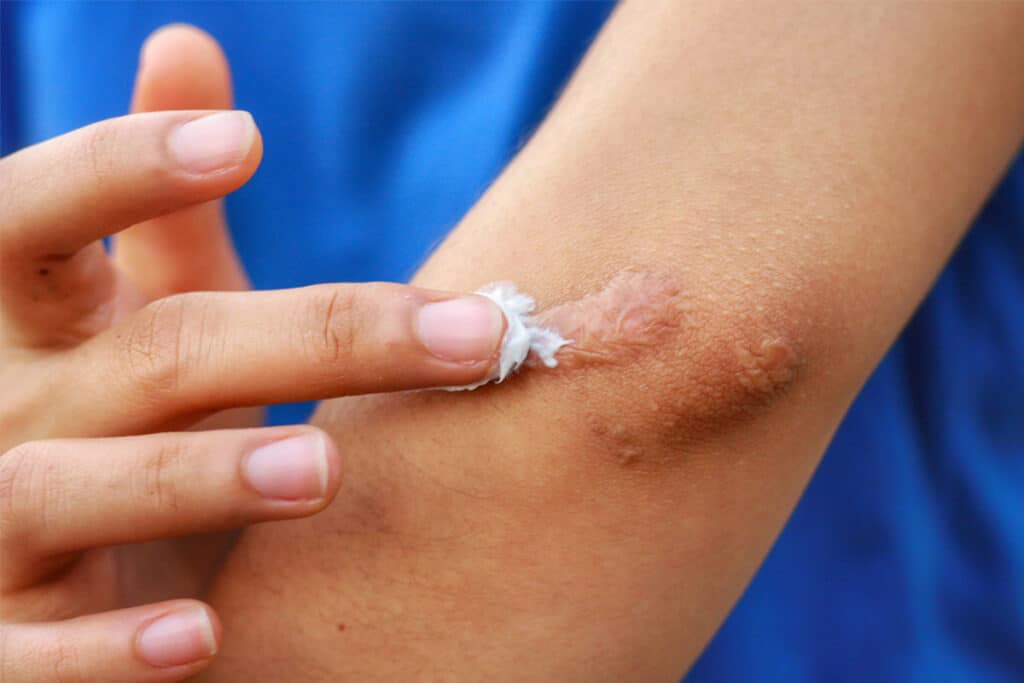Have you ever wondered what happens during a keloid removal surgery? A keloid is a fibrous and noticeable scar that occurs after an injury has healed. Its removal demands careful planning, adept surgical skills, and a comprehensive recovery strategy to avoid recurrence. In this article, we’ll explore the different methods of keloid removal, potential complications, post-surgical recovery process, and prevention strategies.

Understanding Keloids and Their Impact on Skin Health
Keloids are abnormal bumps or protrusions that develop at sites of skin injury, characterized by an overgrowth of scar tissue. It’s vital to note that keloids, while primarily a cosmetic concern, can also impact skin health. These fibrous growths may present discomfort, skin irritation, and even pain in some cases.
They also pose a challenge to the skin’s innate healing capacity. The over-reactive healing response marked by keloid formation interferes with the delicate equilibrium of skin repair and regeneration. Furthermore, keloids can limit skin elasticity, potentially hindering movement in areas like joints.
Typical Treatment Options for Keloids
A variety of treatment options exist for patients with keloids. The primary approach is often therapy and using silicone sheets and gels. They help in flattening the keloids and reducing symptoms like itching and discomfort. Notably, steroid injections are a common treatment regimen, providing effective results by shrinking the keloids.
Another treatment involves using cryotherapy, a therapy type involving cold treatment that can reduce the size of keloids. Laser therapy is also a viable option, which can reduce the keloid’s redness and even help flatten the scar. Radiation therapy is another keloid removal procedure with a high success rate.
Patients must discuss these treatment options with a healthcare provider to determine a suitable choice. Keloid treatment is dependent on the size and location of the keloid and the level of symptoms experienced.
Delving into Keloid Surgery
Keloid surgical removal requires precise execution. The first step involves an incision into the skin where the keloid resides. Surgeons make small, unobtrusive incisions while containing the risk of triggering another keloid formation.
Surgical Incisions in Keloid Removal
The incision process is a delicate balance between removing the keloid and preserving as much healthy skin as possible. The surgeon uses a scalpel to cut around the keloid scar tissue, aiming to excise it without causing unnecessary harm to the surrounding normal skin.
Role of Sutures in Ensuring Closure
Once the keloid is removed, it is crucial to close the incision securely to promote optimal healing of the skin. Sutures play an essential role in this process, holding the skin together to minimize scarring and prevent keloid recurrence. They must be applied with care as pulling too tight might lead to tension on the skin, which could encourage another keloid formation.
A Deeper Look at Surgical Excision
Surgical excision of keloids involves the complete removal of the scar tissue. This technique typically requires the plastic surgeon to cut a margin around the keloid, ensuring that all diseased tissue is removed. This is often followed by a reconstructive surgery technique such as a skin graft, or a local flap procedure that is used to close the wound. The goal of surgical excision is to reduce the size of the scar and improve the appearance of the skin.
Can one Remove all Types of Keloids through Surgery?
It’s crucial to note that surgical excision is not universally effective for all types of keloids. Some are better managed with alternative treatments due to their size, location, or individual patient characteristics. However, surgery can be a beneficial and effective method of removing most types of keloids, with a comprehensive care plan in place to minimize the risk of recurrence.
Understanding the Potential Risks of Surgery of Keloids
Surgical excision of keloids represents a potentially effective remedy, although it is noteworthy that it brings forth a myriad of risk factors. One major risk pertains to the possible return of keloid development, often larger than the original. This is attributed to the skin’s response to the perceived injury.
Other effects such as keloid scarring or discomfort and infection have to be considered too. Furthermore, some patients may suffer from significant pain after surgery. This pain could persist for weeks, demanding meticulous pain management to ensure the patient’s well-being.
Therefore, the decision to undergo a surgical excision should hinge on a careful examination of all these risk factors. Analyzing the health status and predisposition of a candidate for keloid scar surgery to the aforementioned complications is an imperative step toward ensuring a positive post-surgical outcome.
Hypertrophic Scar Risks after Keloid Removal Surgery
Following a surgical excision of a keloid, there’s a risk of developing a hypertrophic scar. Unlike a keloid, a hypertrophic scar doesn’t stretch beyond the original injury zone on the skin. Despite this, hypertrophic scars are aesthetically disruptive and can cause discomfort.
The risk factors contributing to hypertrophic scar formation include genetic predisposition, increased tension on the wound, and the location of the injury. For instance, a wound on the chest region has a higher risk of developing a hypertrophic scar due to the skin’s natural tension and movement.
Ensuring proper wound management post-surgery can minimize the risk. However, each individual’s skin healing process plays a significant role, and it can be unpredictable. Consulting with physicians for appropriate preventive measures is crucial.
Post-Surgical Care for Keloid Removal
After undergoing keloid removal with surgery, taking care of the surgical area is essential. This will not only expedite the healing process but also minimize the risk of infection or complications. Sutures added need to be cleaned and monitored daily to detect any signs of infection such as redness, swelling, or prolonged pain.
Skin Care Tips for Post-Keloid Surgery
Following post-keloid surgery, regular skin care is pivotal in promoting healing and reducing the chances of keloid recurrence. Patients are encouraged to moisturize their skin daily with a gentle, fragrance-free moisturizer. Avoiding sun exposure to the surgical area is also key as it may darken the scar and increase the probability of the formation of keloids. In case sun exposure is inevitable, applying a high-SPF sunscreen is advised.
Take note that the above care instructions aid in skin healing post-surgery, but adherence to the doctor’s prescribed care routine is of utmost importance. This might include specialized care directives based on individual health status, skin type, and size or location of the initial keloid.

Expected Time of Recovery from Keloid Surgery
Recovery time from keloid surgery varies with individuals and the size of the keloid. Generally, the wound from the surgery heals over a few weeks. There may be some discomfort during the healing phase, and it’s imperative to follow prescribed care routines to ensure optimal healing and minimize the risk of keloid recurrence.
Preventing Recurrence after Keloid Removal Surgery
Preventing the recurrence of keloids after removal surgery requires diligent care and the correct type of treatment. Surgeons can minimize the risk by crafting a personalized post-operative plan, including the use of compression therapy, silicone sheeting, or corticosteroid injections. The selection of the most suitable strategy largely depends on individual skin types and the initial wound area.
Steroid Injections after Keloid Scar Removal
Steroid injections play a significant role in influencing the outcome of keloid surgeries. Used both pre and post-surgical excision of keloid scars, these injections can potentially reduce the risk factors associated with the surgery. This effective treatment helps by shrinking the keloid tissue, making the surgical procedure less complex and minimizing the probability of recurrence.
Post-surgical use of steroid injections can also impact the risk profile of a patient. They aid in controlling the excessive production of collagen, which is a root cause of keloid formation. However, it’s crucial to remember that the overuse of steroids can also introduce side effects, which can alter the surgery’s outcome negatively. Thus, the quantity and frequency of steroid injections have to be meticulously regulated.
Choosing the Right Surgeon for Keloid Removal Surgery
When seeking keloid removal Miami Beach, the choice of a competent surgeon becomes paramount. A seasoned surgeon possesses the necessary knowledge to handle different features of keloids using an optimal treatment plan that minimizes trauma to surrounding skin.
If you or someone you know is living with keloid scars, we invite you to book an appointment with Dr. Salloum and Dr. Mendez. As experts in keloid removal, both plastic surgeons strive to provide safe procedures and minimize the risk of complications during surgery. With their extensive knowledge and personalized care, they will ensure that your keloid scar removal procedure is done correctly and efficiently. Don’t wait any longer, contact us today to learn more about our services!